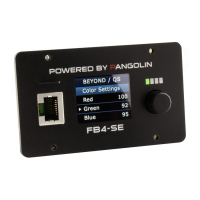Power Connections For the Laser
In addition to showing the connections for the scanner power supply,
Figure 1 also shows the connections for the lasers. However, unlike
the connections for the scanner amplifiers, the connections shown for
the lasers are intended to be more conceptual than literal. The reason
is because, although scanner amplifiers are highly standardized and
generally all require the same kind of power supplies and connections,
the lasers themselves may have integrated AC power supplies and
laser diode drivers, or may each operate on a separate power supply
and driver.
The diagram shows a single power supply operating three solid-state
laser diode drivers, but there may be only a single laser, or in fact the
laser may be an ion laser with completely separate power supply.
Nevertheless, the diagram shows conceptually what must be
accomplished for best results. If the laser power supply is small
enough to fit within the projector, then the “Power Ground” from the
power supply, as well as the “Power Ground” from the laser diode
driver should each be routed to the “Central Grounding Point”. If an
ion laser were used, then a PCAOM would be used to modulate the
beam. In this case, you would connect the Power Supply of the
PCAOM driver, as well as the PCAOM driver each to the “Central
Grounding Point” using a “home-run” type connection.
Projector Interlock (required by the ISP standard)
Figure 1 also shows a relay placed in series with the laser power
supplies. This relay is intended to facilitate the “interlock” feature of
the ILDA Standard Projector. When connected as shown, the laser
diode drivers (and optionally, the shutter driver) will only receive
power when the interlock loop is closed. The interlock facilitates an
additional layer of safety for laser projectors, and is required by the
ISP standard.
It is also possible for users to place a “Red Mushroom Switch” in
series with the ILDA cable and connected to the interlock lines. This

